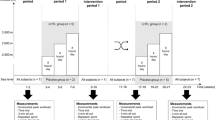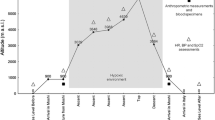Abstract
In this research, we hypothesized that, in rats, adaptation to high altitude (2500 m) plus training at low altitude (610 m), ”living high–training low”, improves physical performance at low altitude more than living and training at low altitude (610 m). Rats were divided into four groups: (1) living at low altitude (LL, n=12), (2) living and training at low altitude (LLTL, n=13), (3) living at high altitude (LH, n=12), (4) living at high altitude and training at low altitude (LHTL, n=13). The program for living at high altitude involved raising rats under hypobaric hypoxia (equivalent to 2500 m), and the training program consisted of running on a tread-mill at low altitude. All groups were raised at each altitude and trained to run at 35 m/min for 40 min/day, 6 days/week for 6 weeks. During this program, we measured heart rates both at rest and during exercise, and performed running-time trials. The mean heart rate during exercise was lower in groups with training than in groups without training, and the groups receiving training could run longer than the untrained groups. The LHTL group especially showed the lowest mean heart rate during exercise and the longest running time among all groups. After 6 weeks of the training program, all rats had a catheter implanted into the carotid artery, and the mean systemic arterial pressure was continuously measured during treadmill running. The rate of increase of this pressure as the running intensity increased was lower in groups with training than in groups without training, especially in the LHTL group. Finally, we anesthetized all the rats and extracted both the right and left ventricles, and the triceps surae and liver. Training increased the weight of the left ventricle, triceps surae, and liver. The increase in weight of the left ventricle and triceps surae was higher in the LHTL group than in the LLTL group in particular. It appeared that living high– training low may be an effective strategy to improve performance ability at low altitude.
Similar content being viewed by others
Author information
Authors and Affiliations
Additional information
Received: 16 July 1999 / Revised: 24 January 2000 / Accepted: 25 January 2000
Rights and permissions
About this article
Cite this article
Miyazaki, S., Sakai, A. The effect of ”living high–training low” on physical performance in rats. Int J Biometeorol 44, 24–30 (2000). https://doi.org/10.1007/s004840050135
Issue Date:
DOI: https://doi.org/10.1007/s004840050135




